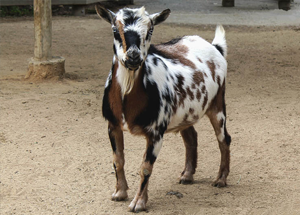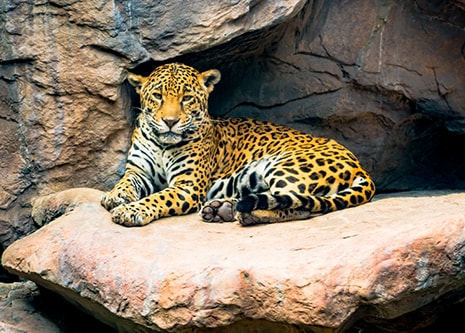
- VisitSupport Happy HollowDONATE TODAYExploreSupport Happy HollowDONATE TODAYLearnSupport Happy HollowDONATE TODAYSupport
-
Today's Hours: 10:00 am to 5:00 pm
Zoo on the HillPygmy goat

Scientific name: Capra hircus
Family: Bovidae
Order: Artiodactyla
Class: Mammalia
Range: Originally from Southwest Asia and Eastern Europe, Domesticated worldwide
Habitat: Urban Lifespan: 15 to 18 years on averageWhat do they look like?
Domestic goats vary greatly in appearance, from the 20-inch tall Nigerian Dwarf to the 200-lb Boer. Their form matches their function – goats have been bred for many different purposes, including pets, weed-eating, agriculture (meat and milk), draft use (pulling carts and carrying loads), and leather. Most breeds come in a variety of colors and patterns. Their hair type can range from long and silky to short and coarse. Some goats have two horns and some have wattles, which are small fleshy nodules on either side of the neck. Depending on the breed, some goats may also have a convex or concave nose, upright or floppy ears, or a beard of hair from the chin.How do they behave?
Goats were among the first animals to be domesticated by people over 8,000 years ago. Their smaller size, varied uses and low nutritional requirements make them easy to keep compared to other farm animals. They are inquisitive and agile, often testing fences and climbing trees. They use their prehensile (capable of grabbing and grasping) upper lip to grasp and nibble at anything within reach. Goats are excellent climbers. Wild goats often live on mountain cliffs or in rocky deserts. Their specialized hooves help them to keep their balance and grip.What’s do they eat?
Any plants they can find! Goats eat weeds, leaves, bark – basically any plant material they come across. They prefer herbs and woody shrubs over grasses, making them very useful in weed abatement; farmers and landowners often keep goats to clear vegetation from hard to mow areas. As ruminants, goats chew their cud, which means that they regurgitate previously chewed food and chew it again. This allows them to extract maximum nutrition from their tough plant food sources. At Happy Hollow, they eat grass hay, timothy hay pellets and grain.How are they born?
Baby goats are called kids. Kids are usually born as single, twin or triplet births, although up to sextuplets occasionally occur. Gestation lasts around 150 days. The female, referred to as a nanny or doe, may produce milk for up to one year after birth, making them useful dairy animals. Goats reach maturity between six to 12 months of age, depending on the breed.Conservation
Domestic goats have not been evaluated by the International Union for Conservation of Nature because they were bred by people and do not belong in the wild. However, these goats do play a vital role in helping impoverished communities through a unique conservation program. Heifer International works with rural communities throughout the globe to provide goats to subsistence farmers. These goats support sustainable agriculture and are vital sources of income to the members of their community. Once the breeding nanny is provided to the family, that family is expected to pass on a female kid to another family within the community. To learn more about Heifer International please visit www.heifer.org
Zoo in the Hollow
Follow the crooked bamboo pathway down into the hollow and visit with some of the most amazing animals in the world. Where else in San José can you get up close to a stunning jaguar, lemur, meerkat or American alligator? Happy Hollow is dedicated to helping save species and preserve wildlife for future generations by participating in Species Survival Plan programs through the Association of Zoos and Aquariums.
See Animals
Education Ambassadors
From camps and classes to scout badges and sleepovers, Happy Hollow education programs have something for everyone! The zoo education program offers a broad range of hands-on, engaging programs and public presentations featuring education ambassador animals. These encounters are designed to connect you to wildlife and the conservation of their habitats around the world.
See AnimalsVisit Us Today
Plan an unforgettable experience at San Jose’s family-friendly park and zoo.
Learn More